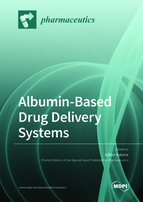Albumin-Based Drug Delivery Systems
A special issue of Pharmaceutics (ISSN 1999-4923). This special issue belongs to the section "Drug Delivery and Controlled Release".
Deadline for manuscript submissions: closed (10 February 2022) | Viewed by 24264
Special Issue Editor
Interests: nose-to-brain delivery; nanomedicine; albumin nanoparticles; polymeric micelles; freeze-drying
Special Issues, Collections and Topics in MDPI journals
Special Issue Information
Dear Colleagues,
Albumin is playing an increasing role as a versatile, biodegradable nano drug carrier in clinical therapy. By applying different formulation techniques, nanoparticles can be prepared from albumin and an active pharmaceutical ingredient. Principally, three drug delivery technologies can be distinguished for binding small-molecule or peptide drugs through the charged amino acids, carboxyl, and amino groups of albumin: physical or covalent binding of the drug to albumin through a ligand- or protein-binding group, the fusion of drug with albumin, and the encapsulation of drugs into albumin nanoparticles. The accumulation of albumin in inflamed tissues and solid tumors forms the rationale for developing albumin-based drug delivery systems for targeted drug delivery.
The current Special Issue aims to focus on the development and optimization of albumin nanoparticles which can be a promising tool in therapy through conventional or alternative administration routes. Research scientists working in this field are therefore invited to contribute by submitting original research articles, review articles, or commentaries.
Dr. Gábor Katona
Guest Editor
Manuscript Submission Information
Manuscripts should be submitted online at www.mdpi.com by registering and logging in to this website. Once you are registered, click here to go to the submission form. Manuscripts can be submitted until the deadline. All submissions that pass pre-check are peer-reviewed. Accepted papers will be published continuously in the journal (as soon as accepted) and will be listed together on the special issue website. Research articles, review articles as well as short communications are invited. For planned papers, a title and short abstract (about 100 words) can be sent to the Editorial Office for announcement on this website.
Submitted manuscripts should not have been published previously, nor be under consideration for publication elsewhere (except conference proceedings papers). All manuscripts are thoroughly refereed through a single-blind peer-review process. A guide for authors and other relevant information for submission of manuscripts is available on the Instructions for Authors page. Pharmaceutics is an international peer-reviewed open access monthly journal published by MDPI.
Please visit the Instructions for Authors page before submitting a manuscript. The Article Processing Charge (APC) for publication in this open access journal is 2900 CHF (Swiss Francs). Submitted papers should be well formatted and use good English. Authors may use MDPI's English editing service prior to publication or during author revisions.
Keywords
- nanomedicine
- albumin nanoparticles
- alternative administration route
- targeted therapy
- functional nanomaterials
- biomaterials







